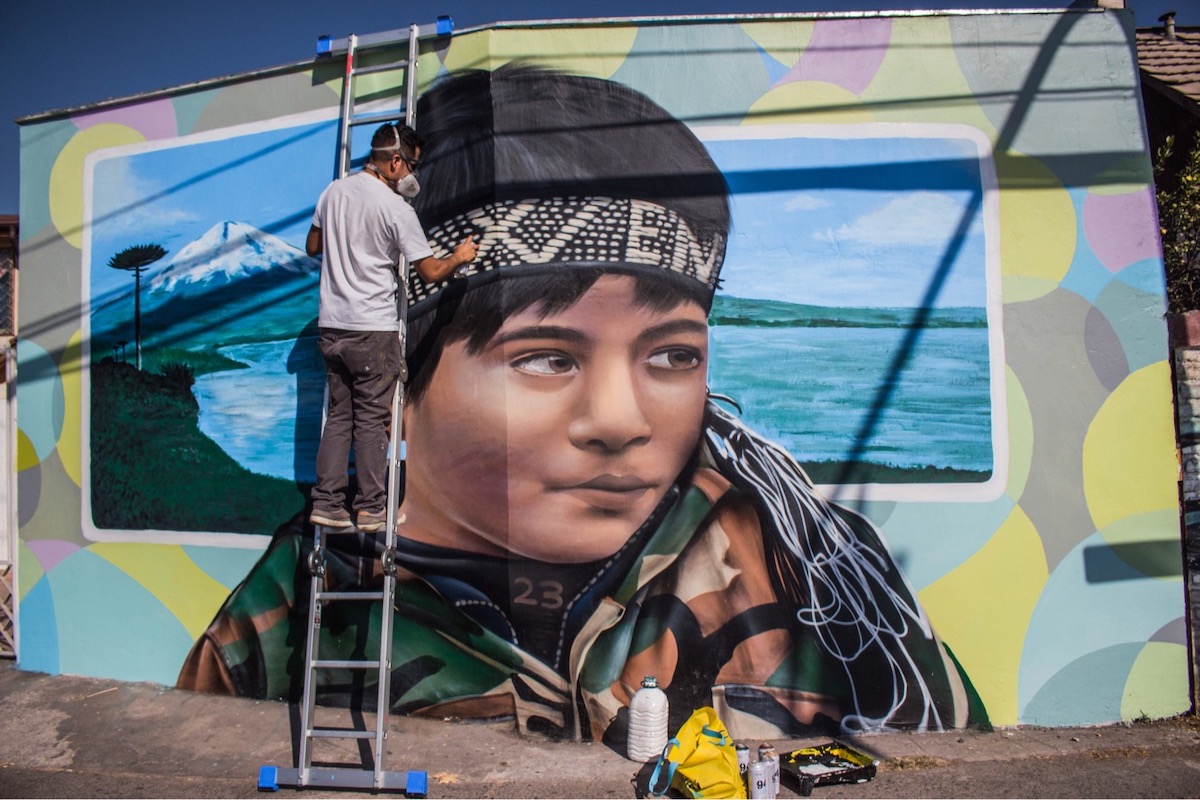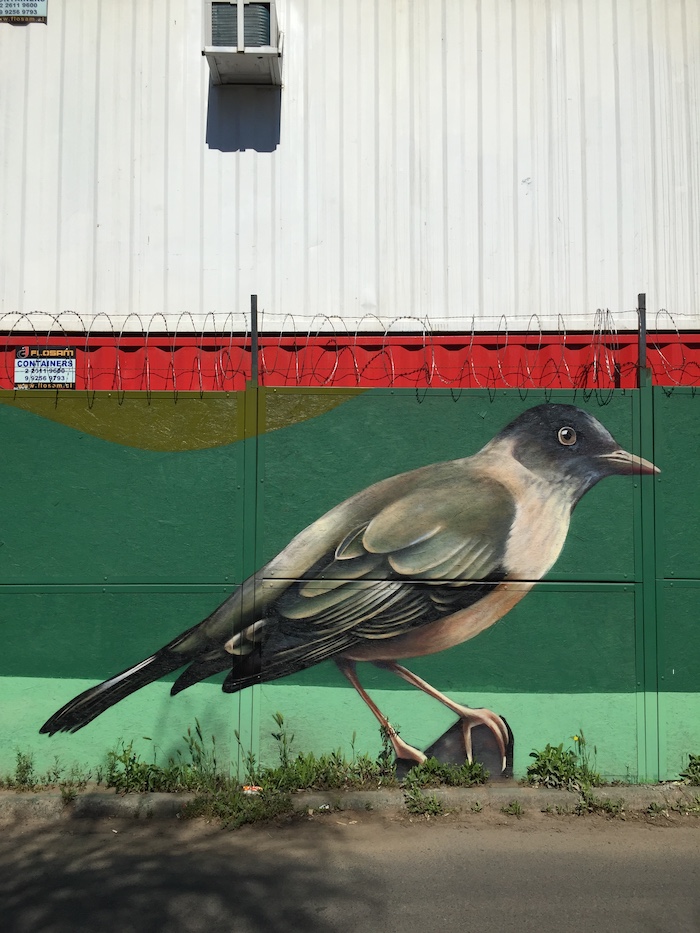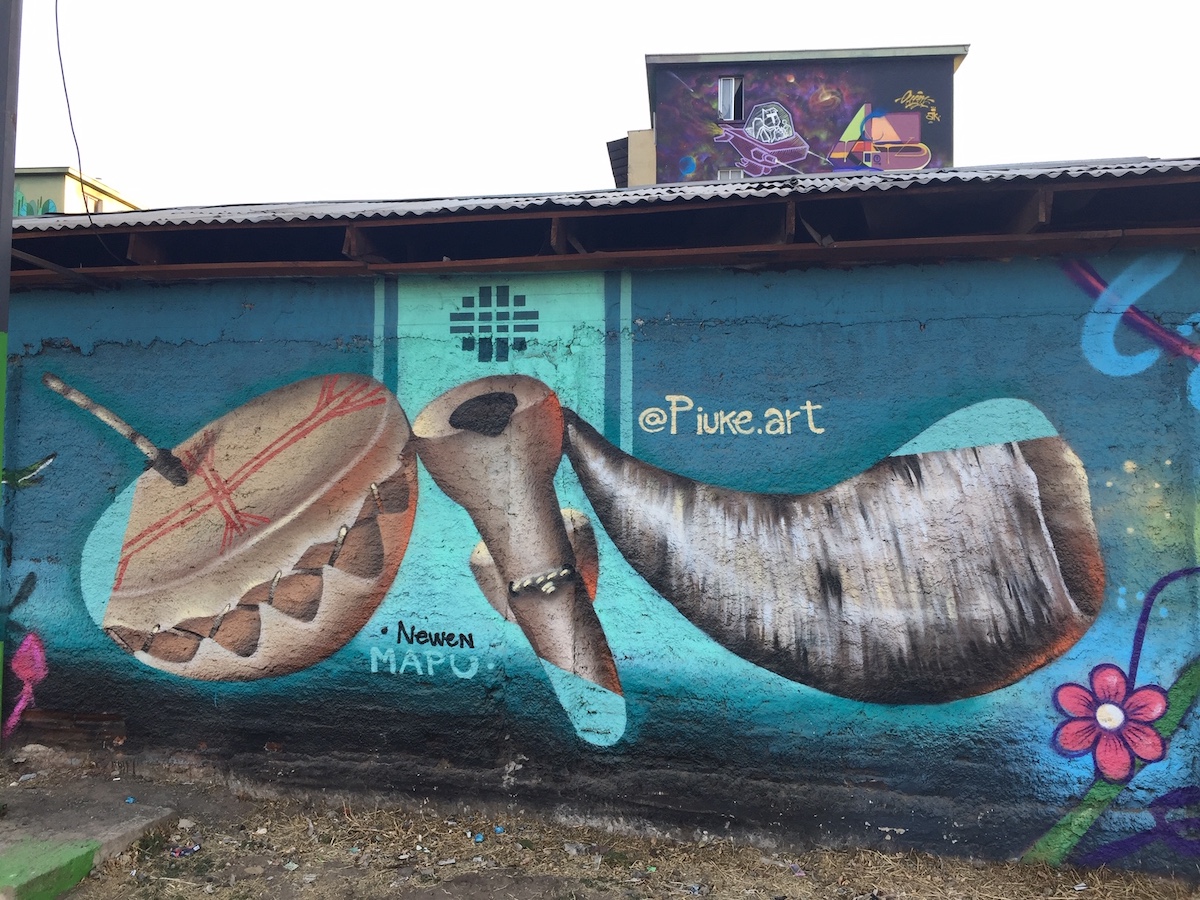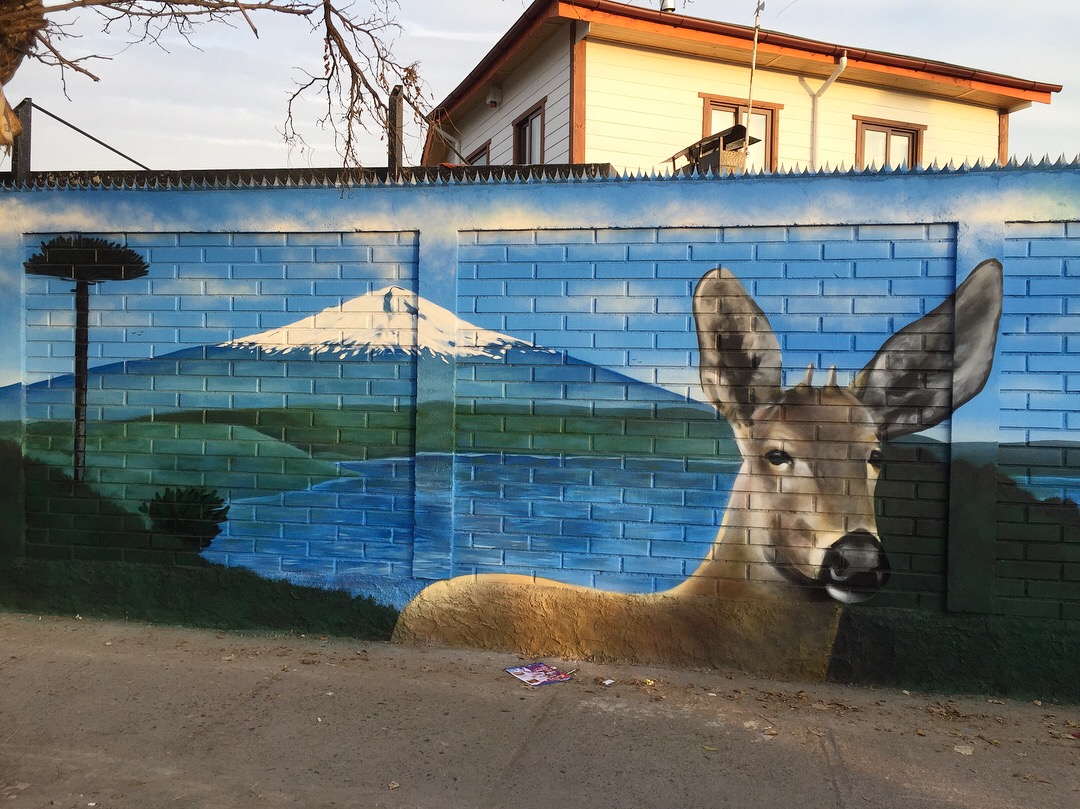

Mariqueo works on “Pichiwentru” mural (Photo courtesy of Alexis Mariqueo)
From an early age, Alexis Mariqueo began expressing his artistic talents at five years old through his drawings.
As he got a little older, Mariqueo’s older brother introduced him to the world of graffiti in Maipú, a commune of Chile’s capital, Santiago.
“From there I began to do more graffiti. Letters and figures and designs,” Mariqueo told Latino Rebels.
During his teens, Mariqueo soon became known in Santiago’s graffiti scene as “Herz,” or “Heart” in German.
But as his artistry developed, producing an estimated 200 pieces, Mariqueo began to sense he was not reflecting his true identity and felt the urge to express his indigenous origins.
“From there I began to paint things relating to Mapuche culture,” said Mariqueo, who settled on the pseudonym “Piuke” which means “heart” in Mapudungún.
This third-generation indigenous Mapuche who grew up in Chile’s capital is aware of his family’s journey to Santiago which has influenced his artwork.
Mariqueo’s grandparents are first-generation Mapuche, born and raised in the southern countryside of Temcuo. But his parents are second-generation Mapuche who grew up in the countryside. He said they were forced to leave for economic reasons—as work became difficult to secure, they uprooted their lives, migrating to the capital.
“My art is a reflection of what it is to be Mapuche. Mapuche people value and respect nature a lot,” Mariqueo explained.


(Photo courtesy of Alexis Mariqueo)
He said this connection to nature has been lost in the modern age and this is something he wishes to reflect in art.
“When I was a child, I remember seeing all the different types of birds that were in the south of the country. There were so many. All of them with their different songs,” Mariqueo said. “When I started painting human figures or landscapes —these kinds of things, I’d paint what I had in my mind— the landscapes of the south, the rivers, the birds, the woods, things involving humans, which served as inspirations to paint.”
When talking about the south of Chile, Mariqueo refers to the Mapuche ancestral lands as “Wallmapu” a name given to the territory south of the Biobío River and encompassing swathes of land across both sides of the Andes in what today is Argentina and Chile. In the late 19th century, the Chilean state fought a bloody “pacification war” against the Mapuche to gain more territory, dispossessing communities to introduce outside settlers.
The Mapuche are one of 10 indigenous peoples in Chile, representing 12.8% of Chile’s population but they have never been recognized in Chile’s constitution.
Mariqueo said such experiences have informed his craft.
“My art has a bit of everything. What I am experiencing currently, what I see and what is happening currently to the Mapuche community. Because my art has a bit of love, resistance, it expresses inequality,” he explained.
The 1980 constitution imposed by the dictatorship instituted an extractivist economic model, impacting the Indigenous way of life, as forestry companies introduced around 70% non-Indigenous species. The legacy has created tensions between the Indigenous community, the state and private enterprise. Amnesty International says environmental defenders and Indigenous leaders working in the area “face constant criminalization and stigmatization” and “multiple forms of discrimination.”


(Photo courtesy of Alexis Mariqueo)
In October 2019, mass demonstrations began in Chile due to what protestors described as rising inequality caused by privatization. Across the nation, the Mapuche Indigenous “Wenufoye” flag became a visible symbol of the community’s struggle and resistance, being prominently displayed during the social uprising. There were reports of Chilean security forces using excessive force, deliberately injuring those taking part in demonstrations.
Mariqueo has previously drawn attention to the issue of state violence. His mural entitled “Pichiwentru” depicts an indigenous child dressed in military clothing, following a 2017 incident that “impacted” Mariqueo, who is a father of a young daughter. That year, Chile’s National Human Rights Institute(INDH) alleged that 42 children at a school, kindergarten and nursery in Temucuicui endured a distressing experience when “all were allegedly attacked with tear gas thrown by officials of the Carabineros de Chile in the context of a police procedure carried out on June 14.”
But in October 2020, after Chile voted to change its constitution, Mariqueo was optimistic about the country’s path forward. This past July, delegates chose Indigenous leader Elisa Loncón to be one of the main architects to draft Chile’s new constitution. Mariqueo described it as a “shift” around how the community is perceived, adding that this recognition is an important step for the community and “an enormous honor” to count on Loncón’s participation.
A Role in Latin American History
Mariqueo himself has had an important role in marking Latin American history.
“El abrazo de los pueblos” is a 300-meter tall mural recalling the battle fought between South American rebels and Spanish royalists during Chile’s War of Independence in Maipú. The artwork required large-scale research. Mariqueo traveled to Argentina, crossing the Andes to learn about the history of the Battle of Maipú and the legacy of historical figures, such as Bernardo O’Higgins and José de San Martín.


(Photo courtesy of Alexis Mariqueo)
“It was a gratifying project which I participated in. I enjoyed the challenge of painting such a large mural. We also worked alongside two other Argentines—two Argentine friends, making it a union of two countries. So it was a beautiful challenge which was achieved in the short time of 16 days,” said Mariqueo, who was awarded a medal recognizing his participation and efforts from Chilean President Sebastián Piñera and the local mayor.
The mural was inaugurated in April 2018 in Maipú. Delegates from both Andean nations were present, with the Presidents of Chile and Argentina attending alongside other prominent ministers.
But the global pandemic and lockdown impacted Mariqueo’s ability to create art on the streets and his call for work. As such, he turned his attention to painting from home.
After the easing of lockdown, Mariqueo created “Mafül,” a mural depicting an indigenous couple embracing and consoling each other. Mariqueo says the image explores notions of solidarity when people face adversity and hardship, such as the inability to see and embrace loved ones during the pandemic.
Today the majority of the 33-year-old’s works are located in Maipú although he has traveled extensively across Latin America, visiting Argentina, Brazil, Colombia and Peru. while participating in a variety of graffiti and mural events.
Mariqueo who regularly shares his art on Instagram says he intends to continue his journey as a visual artist. “Art takes you to many places—good and bad. I’ve painted in favelas in Brazil and in very luxurious places. I’m aware of both realities in Chile. I believe these experiences help one to value what one has.”
His aim now is to continue creating art that both engages people to reflect and challenges assumptions.
“I’m trying to show what is really meaningful for human beings,” he said.
***
Bala Chambers is a freelance multimedia journalist. You may follow him on Twitter at @BalaChambers.


